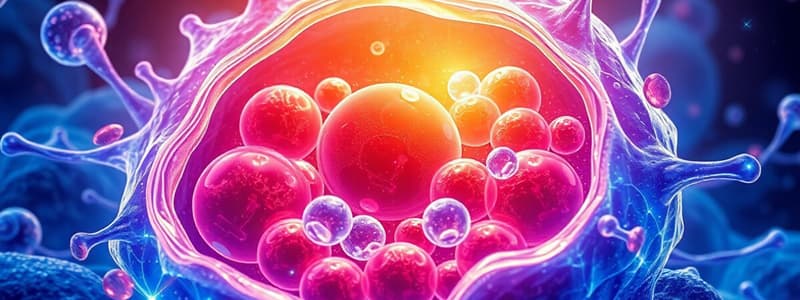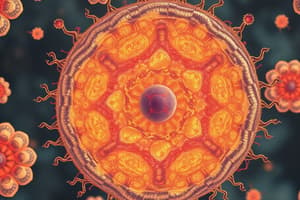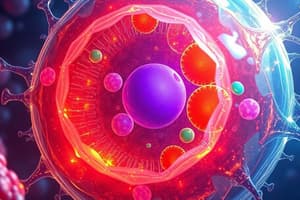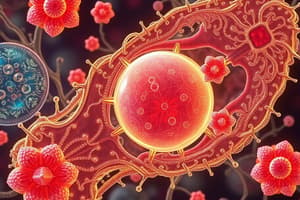Podcast
Questions and Answers
Which of the following statements is true regarding eukaryotic cells?
Which of the following statements is true regarding eukaryotic cells?
- They possess membranous organelles. (correct)
- They are the only type of cell in the human body.
- They lack a plasma membrane.
- They do not contain organelles.
All cells in the human body have the same shape and size.
All cells in the human body have the same shape and size.
False (B)
What is the function of the cytoskeleton?
What is the function of the cytoskeleton?
The cytoskeleton shapes, stabilizes, and moves cells and their internal structures.
The __________ is the flexible barrier that separates the external environment from the internal environment of the cell.
The __________ is the flexible barrier that separates the external environment from the internal environment of the cell.
Match the following components with their primary function:
Match the following components with their primary function:
What type of diffusion does water undergo when moving through an aquaporin?
What type of diffusion does water undergo when moving through an aquaporin?
A hypotonic solution has a higher solute concentration than that of the inside of a cell.
A hypotonic solution has a higher solute concentration than that of the inside of a cell.
In which solution does water move into the cell?
In which solution does water move into the cell?
A ________ solution has the same solute concentration as that inside the cell, resulting in no net movement of water.
A ________ solution has the same solute concentration as that inside the cell, resulting in no net movement of water.
Match the following solutions to their effects on cells:
Match the following solutions to their effects on cells:
What effect does a hypertonic solution have on a red blood cell?
What effect does a hypertonic solution have on a red blood cell?
Why is it important for intravenous (IV) fluids to be isotonic to blood?
Why is it important for intravenous (IV) fluids to be isotonic to blood?
The total concentration of a solution is known as its _____________.
The total concentration of a solution is known as its _____________.
What type of proteins can change shape to move solutes across the membrane?
What type of proteins can change shape to move solutes across the membrane?
Active transport moves substances down their concentration gradients.
Active transport moves substances down their concentration gradients.
What is the term for the movement of substances into cells via a vesicle?
What is the term for the movement of substances into cells via a vesicle?
The sodium-potassium pump keeps Na+ at a higher concentration ______ and K+ at a higher concentration ______.
The sodium-potassium pump keeps Na+ at a higher concentration ______ and K+ at a higher concentration ______.
What is the primary function of the centrosome in animal cells?
What is the primary function of the centrosome in animal cells?
Cilia and flagella are both made up of microtubules.
Cilia and flagella are both made up of microtubules.
What are the small openings in the nuclear envelope called?
What are the small openings in the nuclear envelope called?
The dense region within the nucleus responsible for making ribosomal subunits is called the __________.
The dense region within the nucleus responsible for making ribosomal subunits is called the __________.
Where does transcription occur in human cells?
Where does transcription occur in human cells?
The smooth endoplasmic reticulum is responsible for synthesizing proteins.
The smooth endoplasmic reticulum is responsible for synthesizing proteins.
What kind of enzymes do lysosomes contain?
What kind of enzymes do lysosomes contain?
The __________ is all of the DNA in an organism.
The __________ is all of the DNA in an organism.
Match the organelles with their functions:
Match the organelles with their functions:
What process describes the flow of information from DNA to RNA to protein?
What process describes the flow of information from DNA to RNA to protein?
Ribosomes are assembled in the rough endoplasmic reticulum.
Ribosomes are assembled in the rough endoplasmic reticulum.
What is Tay-Sachs disease?
What is Tay-Sachs disease?
TRNAs carry __________ that match the sequence of mRNA triplets.
TRNAs carry __________ that match the sequence of mRNA triplets.
What structure actively pumps H+ into the interior to maintain a low pH?
What structure actively pumps H+ into the interior to maintain a low pH?
Peroxisomes are involved in detoxifying alcohols.
Peroxisomes are involved in detoxifying alcohols.
What is the primary purpose of mitochondria in cells?
What is the primary purpose of mitochondria in cells?
Mitochondria can replicate independently of the cell's nuclear DNA.
Mitochondria can replicate independently of the cell's nuclear DNA.
What is the process called that begins in the cytoplasm and finishes with ATP synthesis?
What is the process called that begins in the cytoplasm and finishes with ATP synthesis?
The space between the inner and outer mitochondrial membranes is called the __________.
The space between the inner and outer mitochondrial membranes is called the __________.
What phase of the cell cycle involves the replication of DNA?
What phase of the cell cycle involves the replication of DNA?
Meiosis results in identical daughter cells.
Meiosis results in identical daughter cells.
What are the two main types of cell division in humans?
What are the two main types of cell division in humans?
During prophase, chromatin condenses into __________.
During prophase, chromatin condenses into __________.
Which of the following correctly describes telomeres?
Which of the following correctly describes telomeres?
Cytokinesis is the division of the nucleus during cell division.
Cytokinesis is the division of the nucleus during cell division.
What is produced at the end of meiosis II?
What is produced at the end of meiosis II?
The __________ is a specialized protein complex that attaches to the centromere during mitosis.
The __________ is a specialized protein complex that attaches to the centromere during mitosis.
What process occurs during anaphase of mitosis?
What process occurs during anaphase of mitosis?
Match each phase of mitosis with its description:
Match each phase of mitosis with its description:
What percentage of the cell membrane is made up of phospholipids?
What percentage of the cell membrane is made up of phospholipids?
The presence of cholesterol decreases membrane fluidity.
The presence of cholesterol decreases membrane fluidity.
Define membrane fluidity.
Define membrane fluidity.
The lipid bilayer forms a flexible barrier between the inside and the outside of the _____.
The lipid bilayer forms a flexible barrier between the inside and the outside of the _____.
Match the components of biological membranes with their functions:
Match the components of biological membranes with their functions:
Which type of fatty acid contributes to increased membrane fluidity?
Which type of fatty acid contributes to increased membrane fluidity?
Only polar molecules can easily pass through the cell membrane without assistance.
Only polar molecules can easily pass through the cell membrane without assistance.
What role do glycolipids play in the membrane?
What role do glycolipids play in the membrane?
Ion channels provide a pore for _______.
Ion channels provide a pore for _______.
What primarily powers the movement of solutes down their concentration gradients?
What primarily powers the movement of solutes down their concentration gradients?
Peripheral proteins are embedded within the hydrophobic core of the lipid bilayer.
Peripheral proteins are embedded within the hydrophobic core of the lipid bilayer.
Name one factor that affects the rate of diffusion.
Name one factor that affects the rate of diffusion.
Transmembrane proteins span the entire ______.
Transmembrane proteins span the entire ______.
Which of the following statements best describes facilitated diffusion?
Which of the following statements best describes facilitated diffusion?
What is the primary function of the sodium-potassium pump?
What is the primary function of the sodium-potassium pump?
Secondary active transporters use ATP directly to move solutes across the membrane.
Secondary active transporters use ATP directly to move solutes across the membrane.
What process describes the movement of substances out of cells via vesicles?
What process describes the movement of substances out of cells via vesicles?
The movement of water is known as ________ when it moves across a semipermeable membrane.
The movement of water is known as ________ when it moves across a semipermeable membrane.
Match the following transport mechanisms with their definitions:
Match the following transport mechanisms with their definitions:
How does cyanide affect active transport?
How does cyanide affect active transport?
Symporters move two solutes in opposite directions across the membrane.
Symporters move two solutes in opposite directions across the membrane.
Which type of endocytosis involves the intake of specific molecules since they bind to receptors?
Which type of endocytosis involves the intake of specific molecules since they bind to receptors?
The ________ concentration of solutes outside the cell is kept higher due to active transport mechanisms.
The ________ concentration of solutes outside the cell is kept higher due to active transport mechanisms.
What happens during transcytosis?
What happens during transcytosis?
Flashcards are hidden until you start studying
Study Notes
Cell Structure and Function
- Cells are the basic units of life, exhibiting diverse shapes and sizes reflecting their functions. The human body contains approximately 200 different cell types.
- Eukaryotic cells possess membranous organelles, small subunits with specific functions. Prokaryotic cells do not have these.
- The plasma membrane is a flexible barrier regulating material exchange and intercellular communication.
- The cytoplasm, encompassing the space between the plasma membrane and nucleus, facilitates cellular chemical reactions.
- The cytoskeleton, composed of microfilaments (actin and myosin), intermediate filaments, and microtubules (tubulin), provides structural support and enables cell movement.
- The centrosome, in animal cells, organizes microtubules and contains centrioles crucial for mitotic spindle formation.
- Cilia and flagella, composed of microtubules, facilitate cell movement; cilia are short and numerous, flagella are long and singular.
- The nucleus, a membranous organelle with a double membrane (nuclear envelope) and pores, houses DNA and the nucleolus (ribosomal subunit production).
- DNA exists as chromatin (loose and accessible) or chromosomes (tightly wound and inaccessible), with the genome representing an organism's total DNA.
- Ribosomes, composed of rRNA and protein, translate mRNA into proteins; some bind to the rough endoplasmic reticulum (rER).
- The central dogma of molecular biology describes the flow of genetic information: DNA → mRNA → protein. Transcription occurs in the nucleus, translation at the ribosome.
- tRNAs carry amino acids corresponding to mRNA codons (triplets); translation is rapid, with multiple ribosomes often binding a single mRNA transcript.
- The endoplasmic reticulum (ER), a membrane network, synthesizes and modifies proteins (rER) and lipids (sER). The sER also inactivates drugs, participates in carbohydrate metabolism, and stores calcium ions.
- The Golgi complex modifies, sorts, and packages proteins for export; it receives proteins from the rER and modifies them through glycosylation, phosphorylation, etc.
- Lysosomes, membrane-bound sacs containing digestive enzymes, break down cellular molecules; defects can cause lysosomal storage disorders like Tay-Sachs disease.
- Peroxisomes oxidize molecules, metabolize fatty acids, detoxify alcohols, and contain catalase to break down hydrogen peroxide.
- Proteasomes are large cytoplasmic structures that break down large polypeptides into smaller peptides; defects are linked to diseases like Parkinson's and Alzheimer's.
- Mitochondria, double-membraned organelles with cristae (inner membrane folds), perform aerobic cellular respiration, generating ATP from glucose and oxygen. Mitochondria are maternally inherited and contain their own DNA.
Cell Division
- Somatic cells divide by mitosis and cytokinesis, comprising the cell cycle (interphase and M phase). Interphase includes G1 (growth), S (DNA replication), and G2 (cytoplasmic replication) phases.
- DNA replication is semi-conservative; each new DNA molecule consists of one original and one new strand.
- Mitosis, the nuclear division process, consists of prophase (nuclear envelope dissolution, chromosome condensation), metaphase (chromosome alignment), anaphase (chromosome separation), and telophase (daughter cell formation).
- Cytokinesis completes the division by separating the cytoplasm into two distinct daughter cells.
- Chromosomes consist of sister chromatids joined at the centromere; the kinetochore, a protein complex at the centromere, attaches to the mitotic spindle.
- Telomeres, DNA sequences at chromosome ends, protect against shortening and degradation; telomerase elongates telomeres. Shortening telomeres might contribute to aging. Cancer cells often exhibit overactive telomerase.
- Reproductive cells divide by meiosis, producing haploid gametes (eggs and sperm). Meiosis involves two rounds of division, resulting in four genetically different haploid cells. Crossing over of genetic material occurs between homologous chromosomes during Meiosis I.
Membrane Structure and Function
- The fluid mosaic model describes the plasma membrane's structure: a fluid lipid bilayer with embedded proteins and carbohydrates.
- The lipid bilayer is composed primarily of phospholipids (75%), cholesterol (20%), and glycolipids (5%). The amphipathic nature of phospholipids (polar heads, nonpolar tails) drives bilayer formation.
- Membrane fluidity is crucial for function and is influenced by fatty acid saturation (unsaturated fats increase fluidity), cholesterol (a fluidity buffer), and temperature.
- Selective permeability allows only certain molecules to pass; nonpolar, small molecules diffuse easily; polar molecules require assistance.
- Integral membrane proteins are embedded within the hydrophobic core; transmembrane proteins span the entire membrane. Peripheral membrane proteins associate with the membrane through electrostatic interactions.
- Glycoproteins, found on the extracellular face, contribute to the glycocalyx.
- Membrane proteins function as receptors, enzymes, linkers, and cell identity markers.
Membrane Transport
- Simple diffusion is the passive movement of solutes down their concentration gradients (high to low concentration).
- Facilitated diffusion uses membrane proteins (ion channels or carrier proteins) to move substances down their concentration gradients; this includes movement down electrochemical gradients.
- Active transport moves substances against their concentration gradients, requiring energy (usually ATP). This creates and maintains concentration gradients.
Active Transport
- Moves solutes against their concentration gradients.
- Requires energy.
- In animal cells, the sodium-potassium (Na+-K+) pump is a primary active transporter, using ATP hydrolysis to maintain higher Na+ concentration outside and higher K+ concentration inside the cell.
- Secondary active transporters utilize electrochemical gradients established by primary active transporters, moving two solutes simultaneously; one down its gradient (releasing energy), powering the other up its gradient.
- Symporters move both solutes in the same direction, while antiporters move them in opposite directions.
- Cyanide inhibits ATP production, halting all active transport.
Vesicular Transport
- An active transport process using membrane sacs (vesicles).
- Endocytosis: Movement of substances into cells via vesicles.
- Exocytosis: Movement of substances out of cells via vesicles; includes secretion.
- Transcytosis: Movement of substances through cells via endocytosis followed by exocytosis; important for moving large proteins across blood vessel walls.
- Receptor-mediated endocytosis: Imports specific molecules.
- Phagocytosis ("cell eating"): Engulfing and internalizing molecules or invaders into vesicles, fusing with lysosomes for digestion; crucial for immune cells.
- Pinocytosis ("cell drinking"): Bulk-phase endocytosis importing dissolved solutes into vesicles, fusing with lysosomes; important for immune cell surveillance.
- Both endocytosis and exocytosis require ATP hydrolysis.
Osmosis and Water Transport
- Osmosis: Water movement from low to high solute concentration across a semipermeable membrane.
- Water, though small and polar, crosses lipid bilayers inefficiently.
- Aquaporins: Channel proteins facilitating efficient water diffusion across biological membranes; this is considered facilitated diffusion.
- Cells respond differently in various solutions depending on their osmolarity:
- Hypertonic solutions: Higher solute concentration than inside the cell; water moves out.
- Hypotonic solutions: Lower solute concentration than inside the cell; water moves in.
- Isotonic solutions: Same solute concentration as inside the cell; no net water movement.
- IV fluids are usually isotonic to blood to maintain osmotic balance.
Cell Function and Division
- Cell function is compartmentalized by membranous and non-membranous organelles.
- Somatic cells divide via mitosis (producing two identical daughter cells).
- Reproductive cells divide via meiosis (producing four non-identical gametes).
Studying That Suits You
Use AI to generate personalized quizzes and flashcards to suit your learning preferences.




